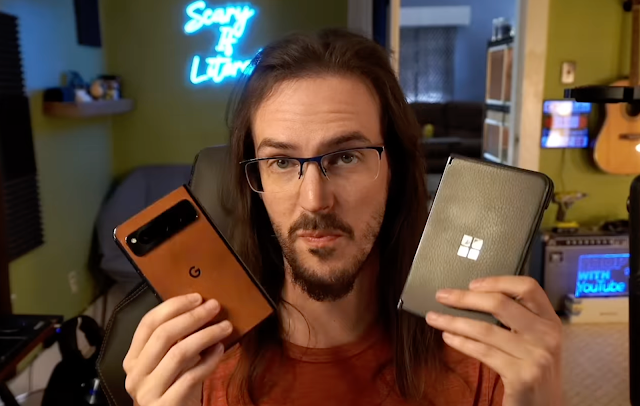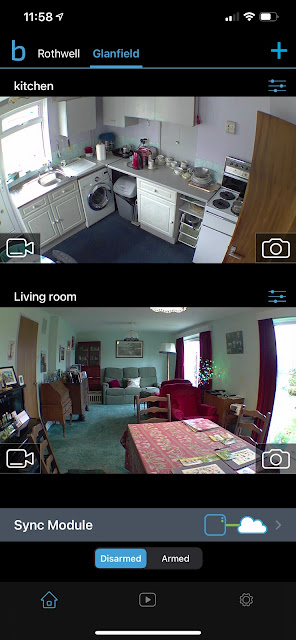Choosing a folding phone in 2023 - why I've plumped for an older device in its last year of support
Phone selection at the top end of the market is a minefield these days, in 2023. Or perhaps you're spoiled for choice. It depends on whether your glass is half empty or half full - or on the depth of your wallet!
And I made a curious decision recently that surprised me - I rejected the Samsung Galaxy Z Fold 5 and Google Pixel Fold in favour of the two year old Microsoft Surface Duo 2. I should emphasise that this wasn't a specs-based or wallet-based choice - I had the Pixel Fold in hand at the same time, and only recently had a month with the Galaxy Z Fold 4 (the 5 is only a minor update). So I had experience galore with the concept and form factors.
Shane Craig is big into these devices too and I recommend you check out his YouTube channel.
The device I hadn't played with, perhaps surprising given the sheer number of 'gift' devices showered on other tech YouTubers, was the OnePlus Open, but although this is a super slice of technology, its insistence of trying to flatten the folding 'crease' at all costs has me worried, from a physics and engineering standpoint - but that's perhaps an editorial for another day.
So yes, when thinking about phones that are actually pocket-sized, unfolding mini-tablets(!), I've ended up (back) on the Surface Duo 2 - while not quite as elegant a dual-screened form factor as the original Duo, it does have an extra year of software support, better cameras, speakers, and all round specifications.
Why the Duo 2 over its more expensive 2023 folding counterparts? To misquote Shakespeare, let me count the ways...
1. Durability
After going through several phones with folding displays (using bendy 'ultra-thin glass' with plastic on top), I remain unconvinced by the technology. Yes, it's all very clever and there's s big wow factor, but displays aren't meant to be bent tens of thousands of times.
Yes, manufacturers will quote a '300,000' or similar figure in the labs, under controlled and perfect conditions, but in the real world, with dust, food, moisture, temperature extremes, physical abuse (including drops), there is NO WAY that a folding display can be guaranteed to last the support lifetime of the phone.
It's still early days for data points, but I've seen photos in just the last week of a Pixel Fold with unsightly under-display bulge and a OnePlus Open with broken pixels. Holding the Pixel Fold in my hands, I asked myself the chances of it having zero display issues in, say, three years of normal use, and came up with 50:50. At best.
Yes, there's usually some warranty to take care of actual defects for a year (or two in Google's case), but you can't guarantee that the manufacturer won't wriggle out of honouring this by spotting dents and scratches and claiming that the damage is caused by the user.
In contrast, the Surface Duo 2 has two Gorilla Glass Victus displays that are as tough as any top end regular 'candy bar' form factor, so will resist pressure, scratches, and general abuse. They're hinged with a simple top/bottom dual cam set-up and the cams are the only moving parts. So there's a lot less to break.
If you're interested, the two phone/tablet halves communicate through bundles of tiny wires routed through spare space on the inner face of each cam section, as shown here:
(The outer faces of the Surface Duo are also Gorilla Glass and I prefer to 'skin' these anyway, for more grip, as shown in some of the photos in this article.)
2. Displays
The inner screens on the Galaxy Z Fold 5 and Pixel Fold are pretty good - colourful and detailed. But the enforced plastic top layer does mean that there are compromises. The Pixel's, in particular, is quite reflective, plus on both there's the very visible 'valley', the crease, which is where the display starts to fold inwards when you close the device.
Pros and cons when comparing to the Surface Duo 2. This has top quality conventional 90Hz AMOLED displays with anti-glare, anti-reflection, and oleophobic coatings - with a dark theme applied, they're simply gorgeous, even by 2023 standards. The 'con' is, of course, the gap in the middle, literal air for almost half a centimetre, though in practice this isn't an issue, as the content on each screen is usually separate in some way. Only when spanning video playback or a game across the two do you miss out on some pixels.
The Duo 2 displays are also wide and large, compared to the other devices. This leads to an 8.3" tablet capability (compared with 7.6" on both the Z Fold 5 and Pixel Fold). So you can, in theory, do more, and, when using the Duo 2 fully folded back as a candy bar form factor, you have a wider keyboard to type on.
3. Stereo speakers
All of this so far is factual but with some subjectivity. Now we venture slightly further towards the latter. When I watch video on YouTube or Netflix or whatever, I want stereo audio. I want ambience and atmosphere, at least as much as is possible on phone speakers. So, I was disappointed, by default, with the Pixel Fold and Z Fold 5, in that their speakers are, respectively, either not separated much horizontally or in fact one directly above the other. So not much of a stereo sound stage.
Yes, I know, I can rotate either foldable so that the speakers are then directly left and right, but there's then the issue of the video image having a fold crease running through the centre of the frame, horizontally. So it's not ideal.
In contrast, the Surface Duo 2 is designed with one speaker top left and one bottom right, giving a decent left/right stereo sound stage. And if you rotate the Duo 2 into 'tent mode' or 'laptop mode' then audio is still full stereo. Clever. The Pixel Fold almost had the idea, but kept the speakers too close to its hinge.
I realise this is a little niche, but stereo sound is important to me.
4. Multitasking
- The Samsung Z Fold 5 can handle up to 4 applications on screen at once (the last via a pop-up window), but real estate for each makes apps not that useable.
- The Pixel Fold shows just two apps at once, side by side, but you can drag the divider to set the content split as needed (albeit with a refresh of the larger app to re-load its content)
- The Surface Duo 2 is also limited to two apps and each is limited in size by the respective displays
5. Android is Android and Google Play Services are... you know
Although Google's narrative is that you need a Pixel to really appreciate the best of Google, and while this is true for gadgets like their 'Now playing' widget and various phone call and transcription services, in fact everything else Google does is available for other Android phones, at least outside China.
So, on the (now two years old) Surface Duo 2, we have:
- the latest Android monthly security updates
- the latest Play Security updates (all the under the hood stuff that keeps Android apps ticking along and doing things)
- the latest Google applications from the Play Store (Maps, Drive, Photos, Gmail, etc.)
The 'Pixel Experience', as Google likes to put it, is a 'thing' - but not a huge thing to me. Any Android phone (and I have a few here all the time) can get close with the latest of everything listed above.
Onward recommendations
Of course, the Surface Duo 2 is impossible to find 'new' anymore, and is relatively rare on the second hand market, making it hard to recommend that someone, perhaps you reading this, should follow in my footsteps. But at least you'll now understand some of my thought processes when you see me fondling or showing off the Duo 2 on social media (Twitter, Mastodon) or on camera on my YouTube channel...
And if you should happen to see the Duo 2 in your own preferred second hand site or shop then look for a bargain and perhaps take a chance on it - there's still lots to like!
PS. If you like this feature and want to support my work then please do so here via PayPal. Thanks.








Comments